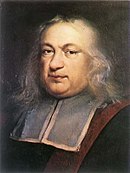Fermat's Last Theorem/Pierre de Fermat
Pierre de Fermat
[edit | edit source]
Pierre de Fermat (1601–1665) - French Magistrate.
Although his work as a magistrate was very demanding, Fermat found the time to dedicate himself in a most profitable way to the study of Mathematics. Even though he was not a professional mathematician by training Fermat made important contributions in the study of functions and of the theory of numbers. Fermat conducted an intimate correspondence with various mathematicians of the era, but his natural reserve together with a notable reluctance in making known his discoveries resulted in his genius being discovered a long time after his death, when his son decided to collect his father’s papers and make them public. The famous enigma was idealised by Fermat while he was studying the Arithmetica of Diophantus of Alexandria, mathematician 212 A.D. to 298 A.D. Diophantus’ book collected together many elegant proofs of complete solutions to problems that mathematicians had faced over the course of centuries; reading the part concerning the Pythagorean triads, one supposes that Fermat may have had the idea of extending the power of 2 to a generic n. Fermat wrote in note in the book the enunciation of his famous theorem and then added:

Cuius rei demonstrationem mirabilem sane detexi hanc marginis exiguitas non caperet.
- [I have discovered a truly marvellous proof of this, which however the margin is not large enough to contain.]
The unresolved theorem
[edit | edit source]Fermat was accustomed to annotating his books: many theorems were found in their margins, generally without proof. The proof of these theorems was in some cases simple while in other cases it required hard work. The last theorem in fact takes its name from the fact of being the last of Fermat’s theorems to be proved, not from the fact of having been the last to be enunciated. To be precise, rather, its name was incorrect: until 1994 when it was proved, rather than a theorem it was strictly speaking a conjecture. The majority of mathematicians however used this name: in fact they held it true though not being able to prove it, given that the majority of the affirmations of Fermat had proved themselves true. It goes without saying that these facts are not sufficient to render a conjecture a theorem, but the majority of mathematicians in this particular case passed over this detail without too many problems.
